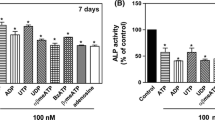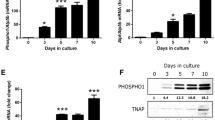Summary
We have examined the effect of adriamycin, an anthracycline antibiotic which modifies plasma membrane functions, on the cyclic AMP response to PTH and PGE2 in isolated osteoblastlike cells. Adriamycin blunted the increment in bone cell cyclic AMP caused by exposure to PTH. This effect appeared rapidly (within 3 min after bone cells were exposed to adriamycin) and disappeared soon after exposure of adriamycin-treated cells to adriamycin-free incubation medium. Inhibition was evident over the entire time course of PTH action, at low as well as high PTH concentrations, and was one-half maximal at 31 µM adriamycin. It could not be attributed to alterations in cyclic AMP exodus, degradation or interference with the cyclic AMP assay, nor to impaired cell viability. Adriamycin also reduced the stimulatory effect of PTH on adenylate cyclase activity in a crude plasma membrane preparation. By contrast, adriamycin failed to modify the effects of PGE2 on cyclic AMP generation in intact bone cells, and on adenylate cyclase activity in broken cells. Moreover, concentrations of adriamycin that blunted the effect of PTH on adenylate cyclase activity did not inhibit the stimulatory effects of sodium fluoride or of GppNHp. These results suggest that adriamycin selectively alters the interaction between PTH and its receptor or impairs the transmission of information from hormone-receptor complex to adenylate cyclase (or both), perhaps by binding to specific lipid domains in the plasma membrane. Structural analogues of adriamycin, which vary in their lipophilic properties, also varied in their capacity to perturb the cyclic AMP response. One such analogue in fact inhibited the response to PGE2, and several appeared to augment the PGE2 effect. These substances may well be useful in probing the membrane properties required for selectivity in hormone action.
Similar content being viewed by others
References
Peck WA, Klahr S (1979) Cyclic nucleotides in bone and mineral metabolism. Adv Cyclic Nucleotide Res 11:89–130
Rodan GA, Martin TJ (1981) Role of osteoblasts in hormonal control of bone resorption—a hypothesis. Calcif Tissue Int 33:349–351
Peck WA (1979) Cyclic AMP as a second messenger in the skeletal actions of PTH: a decade old hypothesis. Calcif Tissue Int 29:1–4
Raisz LG, Koolemans-Beynen AR (1974) Inhibition of bone collagen synthesis by prostaglandin E2 in organ culture. Prostaglandins 8:377–385
Partridge HC, Alcorn D, Michelangeli VP, Kemp BE, Ryan GB, Martin JJ (1981) Functional properties of hormonally responsive cultured normal and malignant rat osteoblastic cells. Endocrinology 108:213–219
Dziak RM, Hard D, Migasaki KT, Brown M, Weinfeld N, Hausmann E (1983) Prostaglandin E2 binding and cyclic AMP production in isolated bone cells. Calcif Tissue Int 35:250–257
Reith EJ (1983) A model for transcellular transport of calcium based on membrane fluidity and movement of calcium barrier within the more fluid microdomains of the plasma membrane. Calcif Tissue Int 35:129–134
Goormaghtigh E, Chalelatin P, Casper J, Puysschart JM (1980) Evidence of a complex between adriamycin derivatives and cardiolipin: possible role in cardiotoxicity. Biochem Pharmacol 29:3003–3010
Burks JK, Peck WA (1977) Bone cells, biochemical and biological studies after enzymatic isolation. Science 146:1476–1477
Burks JK, Peck WA (1978) Bone cells: a serum-free medium supports proliferation in primary culture. Science 199:542–544
Peck WA, Kohler G, Barr S (1981) Calcium-mediated enhancement of the cAMP response in cultured bone cells. Calcif Tissue Int 33:407–416
Peck WA, Kohler G (1980) Hormonal and nonhormonal desensitization in isolated bone cells. Calcif Tissue Int 32:95–103
Murphree SA, Cunningham LS, Hwang KM, Sartorelli AC (1976) Effects of adriamycin on surface properties of sarcoma 180 ascites cells. Biochem Pharmacol 25:1227–1231
Gosalvez M, Van Rossum GD, Bianco MF (1979) Inhibition of sodium-potassium activated ATPase and ion transport by adriamycin. Cancer Res 39:257–261
Karczmar GS, Tritton TR (1979) The interaction of adriamycin with small unilamillar vesicle liposomes. Biochim Biophys Acta 557:306–319
Murphree SA, Tritton TR, Smith PL, Sartorelli AC (1981) Adriamycin-induced changes in the surface membrane of sarcoma 180 ascites cells. Biochim Biophys Acta 649:317–324
Azuma J, Sperelakis N, Hasegawa H, Tamimoto T, Vogel S, Ogura K, Awata N, Sawamura A, Harado H, Ishiyama T, Morita Y, Yamamura J. (1981) Adriamycin cardiotoxicity: possible pathogenic mechanism. J Molec Cell Cardiol 13:381–397
Solie TN, Yuncker C (1978) Adriamycin-induced changes in translocation of sodium ions in transporting epithelial cells. Life Science 22:1907–1920
Caroni P, Villani F, Carafoli E (1981) The cardiotoxic antibiotic doxorubicin inhibits the Na+/Ca2+ exchange of dog heart sarcolemmal vesicles. FEBS Lett 130:184–186
Choudhury SR, Deb JK, Choudhury K, Neogy RK (1982) Inhibition of uridine transport through sarcoma-180 cell membrane by anthracycline antibiotics. Biochem Pharmacol 31:1811–1814
Lo TM, Boyle MDP (1979) Relationships between the intracellular cAMP level of tumor cells and their sensitivity to killing by antibody and complement. Cancer Res 39:3151–3162
Unverferth DV, Fertel DRH, Talley RL, Magorien RD, Balcerzak SP (1981) The effect of first-dose doxorubicin on the cyclic nucleotide levels of the human myocardium. Toxicol Appl Pharmacol 60:151–154
Young DM, Fioravanti JL, Olson HM, Prieur DJ (1975) Chemical and morphological alteration of rabbit bone induced by adriamycin. Calcif Tissue Int 18:47–63
Author information
Authors and Affiliations
Additional information
Supported by NIH grant AM 19855-07
Rights and permissions
About this article
Cite this article
Kohler, G., Shen, V. & Peck, W.A. Adriamycin inhibits PTH-mediated but not PGE2-mediated stimulation of cyclic AMP formation in isolated bone cells. Calcif Tissue Int 36, 279–284 (1984). https://doi.org/10.1007/BF02405331
Issue Date:
DOI: https://doi.org/10.1007/BF02405331




